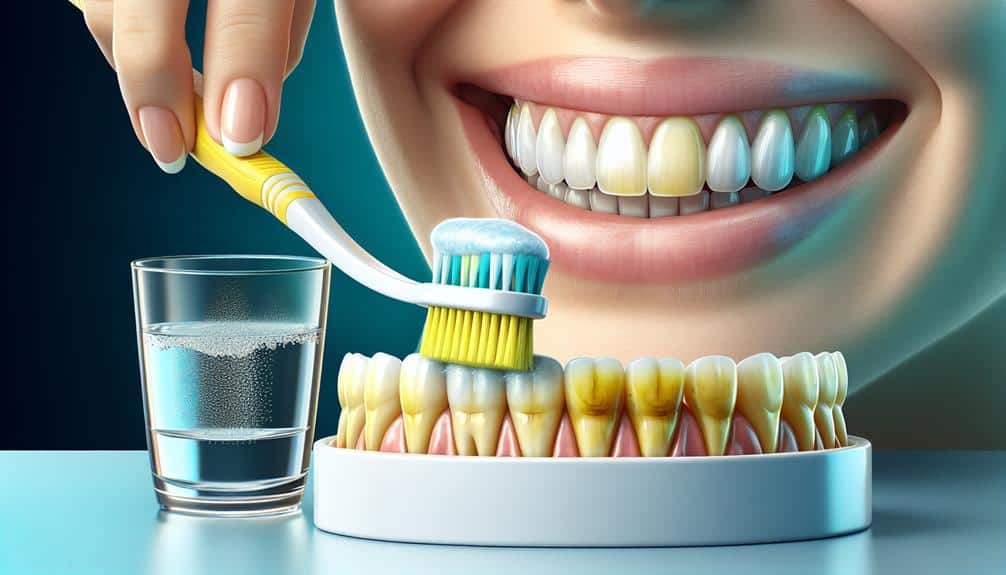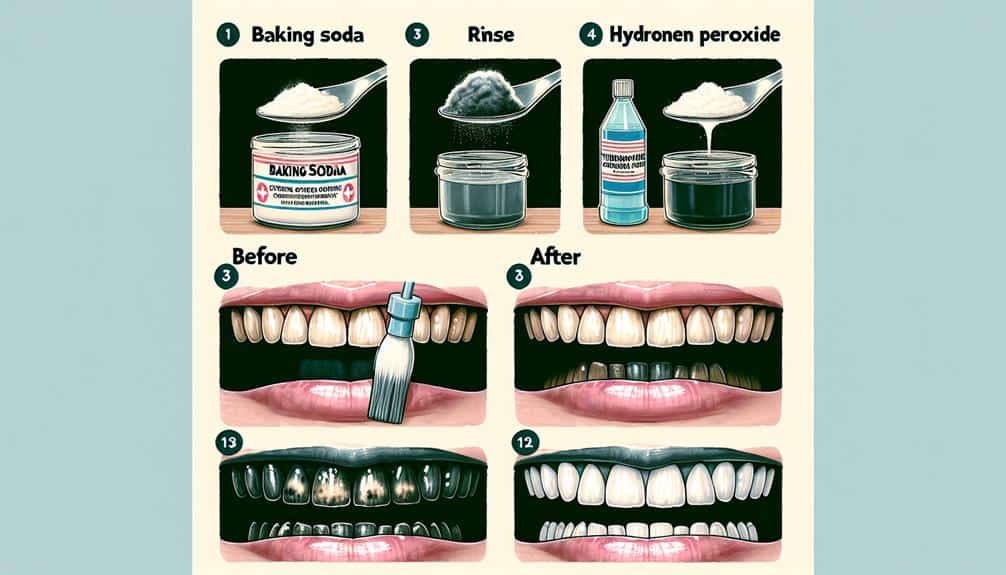To master tetracycline teeth whitening, begin with a detailed consultation to evaluate your needs. Develop a personalized treatment plan based on the severity of stains and your oral health. Manage sensitivity with desensitizing products and follow treatment guidelines strictly. Monitor progress, adjust if needed, and maintain consistency for best results. Long-term maintenance involves regular dental check-ups, good oral hygiene, and avoiding teeth-staining foods. Each step plays an essential role in achieving a brighter smile. Ready to take the next steps towards brighter teeth?
Key Points
- Understand tetracycline stain mechanism for effective treatment.
- Consult experienced professionals for personalized whitening plans.
- Manage sensitivity with desensitizing products and soft-bristled brushes.
- Follow treatment duration, frequency, and timing guidelines strictly.
- Maintain oral hygiene, regular check-ups, and avoid stain-causing foods for long-lasting results.
Understanding Tetracycline Teeth Whitening
To understand tetracycline teeth whitening, it's important to grasp the specific mechanism through which tetracycline stains affect tooth coloration. Tetracycline, an antibiotic, can cause intrinsic stains on teeth when taken during tooth development. These stains can range from yellow to dark brown or gray, posing a significant challenge in achieving a bright smile. When exploring tetracycline teeth whitening, exploring alternatives to tetracycline and strategies for stain prevention are vital aspects.
Tetracycline alternatives such as cosmetic dental procedures like veneers or bonding may be examined for individuals with severe tetracycline stains. These methods can effectively cover the stained teeth, providing a more aesthetically pleasing appearance. Stain prevention is another important aspect to take into account when dealing with tetracycline stains. Maintaining good oral hygiene practices, avoiding foods and beverages that may exacerbate staining, and regular dental cleanings can help prevent further discoloration and maintain the whiteness of teeth. Understanding these alternatives and preventive measures is essential for effectively managing tetracycline stains and achieving a brighter smile.
Causes of Tetracycline Stains
When considering tetracycline stains, understanding the root causes of discoloration on teeth is vital. Tetracycline stains result from the incorporation of tetracycline antibiotics into the tooth structure during the development of teeth. This incorporation happens when these antibiotics are ingested during childhood when the teeth are still forming, leading to a yellow, brown, or gray discoloration that's challenging to remove through regular brushing or over-the-counter whitening products.
Professional whitening techniques are often necessary for effectively removing tetracycline stains. These techniques may involve the use of high-concentration bleaching agents and specialized procedures tailored to address the specific nature of tetracycline discoloration. It's important to consult with a dental professional experienced in tetracycline stain removal to determine the most suitable treatment plan for your individual case.
Consultation and Evaluation Process
Engage in a thorough consultation and evaluation process to determine the best approach for addressing tetracycline stains on your teeth. During this process, it's essential to use advanced evaluation techniques to accurately assess the extent of the stains and identify the most suitable treatment options based on your specific needs.
Here are some key points to contemplate:
- Detailed Examination: Conduct an in-depth evaluation of your dental history, the severity of tetracycline stains, and any other dental issues to create a personalized treatment plan.
- Communication: Clearly convey your expectations and desired outcomes to your dentist to ensure alignment and realistic goal setting for the whitening process.
- Realistic Expectations: Understand the limitations of tetracycline teeth whitening and discuss with your dentist the expected results based on the severity of the stains.
Customized Treatment Plans
Crafting a personalized treatment plan is essential when addressing tetracycline stains on your teeth for best results. A customized approach tailored to your specific needs and preferences is vital for achieving the best possible outcomes. By considering factors such as the severity of the stains, your oral health condition, and your desired level of whitening, a personalized care plan can be developed to maximize treatment success.
During the consultation process, your dentist will assess the extent of the tetracycline staining and discuss various treatment options with you. This is the ideal time to communicate your preferences and expectations, allowing for a treatment plan that aligns with your goals. Whether you prefer an in-office procedure for faster results or a gradual at-home whitening regimen, a customized approach can be designed to suit your lifestyle and desired outcomes.
Managing Sensitivity Issues
If you're experiencing sensitivity during tetracycline teeth whitening, try applying a desensitizing toothpaste before and after the treatment.
Additionally, consider using a soft-bristled toothbrush to prevent further irritation.
Remember to inform your dentist about any existing sensitivity issues for appropriate guidance.
Sensitivity Prevention Tips
To minimize sensitivity when undergoing tetracycline teeth whitening treatment, it's essential to follow specific preventive measures diligently. Here are some tips to help you manage sensitivity and protect your enamel:
- Use a desensitizing toothpaste: Prior to treatment, start using a desensitizing toothpaste containing potassium nitrate to help reduce sensitivity.
- Avoid acidic foods and drinks: Acidic substances can weaken enamel, making teeth more sensitive. Steer clear of citrus fruits, sodas, and other acidic items.
- Stay hydrated: Drinking water helps maintain saliva flow, which aids in remineralizing enamel and reducing sensitivity.
Handling Existing Sensitivity
When addressing existing sensitivity during tetracycline teeth whitening treatment, it's important to prioritize measures that help alleviate discomfort and protect the enamel. Sensitivity management is vital for a comfortable whitening experience.
To manage sensitivity effectively, consider using toothpaste designed for sensitive teeth. These toothpaste options typically contain ingredients that can help reduce pain and discomfort during and after whitening treatments.
Additionally, you can apply desensitizing gel to your teeth before whitening to minimize sensitivity. This gel acts as a barrier, shielding the nerves in your teeth from the bleaching agents.
Pain relief can also be achieved by avoiding extremely hot or cold foods and drinks for a few days following the whitening procedure.
Post-Treatment Care Instructions
After completing your Tetracycline teeth whitening procedure, following the recommended post-treatment care guidelines is vital for optimal results. Here are some important steps to follow for post-treatment care:
- Maintain Good Oral Hygiene: Continue to brush your teeth at least twice a day and floss daily to prevent staining and uphold the whitening effects.
- Avoid Staining Foods and Beverages: Stay away from dark-colored foods and drinks like coffee, tea, red wine, and berries that can stain your teeth and diminish the effectiveness of the whitening treatment.
- Attend Regular Dental Check-ups: Schedule and attend routine dental check-ups to monitor the outcomes of the treatment, address any concerns promptly, and guarantee long-lasting whitening effects.
Following these post-treatment care instructions diligently will help you preserve the outcomes of your Tetracycline teeth whitening procedure and maintain a bright, radiant smile.
Combining Tetracycline Whitening With Other Procedures
Consider incorporating additional dental procedures alongside Tetracycline teeth whitening to enhance and customize your overall treatment plan. When dealing with stubborn Tetracycline stains, it might be beneficial to explore whitening alternatives such as custom tray whitening or in-office bleaching procedures. These methods can help address deep discoloration, providing a more thorough whitening effect.
Combination therapies offer a tailored approach to tackle Tetracycline staining effectively. Combining Tetracycline teeth whitening with procedures like microabrasion or veneers can yield ideal results, especially for severe cases. Microabrasion can help remove superficial stains, while veneers offer a long-lasting solution for deeply discolored teeth.
Discuss with your dentist the possibility of incorporating these additional procedures into your Tetracycline teeth whitening treatment. By utilizing whitening alternatives and combination therapies, you can create a personalized plan that targets your specific needs, ensuring a successful outcome in your quest for a brighter, whiter smile.
Duration and Frequency of Treatments
When undergoing Tetracycline teeth whitening treatments, it's vital to follow the recommended treatment duration guidelines to achieve best results.
Additionally, sticking to the frequency recommendations provided by your dental professional is key for the effectiveness of the whitening process.
Timing plays a significant role in the success of the treatment, so make sure you follow the suggested schedule for the best outcome.
Treatment Duration Guidance
For best outcomes with tetracycline teeth whitening, make sure you follow the recommended treatment duration and frequency guidelines. To optimize your treatment experience, consider the following:
- Monitor Treatment Progress: Regularly assess the changes in tooth color to gauge the effectiveness of the tetracycline teeth whitening treatment.
- Adjust Duration as Needed: If you notice slower progress than expected, consult with your dentist to make necessary duration adjustments or tweaks.
- Seek Expert Guidance: Always seek professional advice when altering the treatment duration to guarantee safety and effectiveness in whitening your teeth.
Following these guidelines will help you achieve the desired results efficiently and effectively in your journey to whiter teeth.
Frequency Recommendations
To maximize the effectiveness of tetracycline teeth whitening, adhere to the recommended treatment frequency and duration guidelines. Consistency is key when it comes to achieving best results.
The ideal treatment intervals for tetracycline teeth whitening typically range from once a week to once every few weeks, depending on the concentration of the whitening agent used and the sensitivity of your teeth.
It's essential to follow the recommended schedule provided by your dentist or the product manufacturer to avoid overuse, which can lead to tooth sensitivity or enamel damage.
Timing for Best Results
For best results in tetracycline teeth whitening, adhere closely to the recommended timing for treatments, ensuring both the proper duration and frequency are followed diligently. When it comes to application techniques, ideal timing is essential. Here's what you need to know:
- Consistency is Key: Maintain a regular schedule for treatments to allow the whitening agent to work effectively.
- Follow Guidelines: Stick to the recommended duration specified by the product or your dental professional for each session.
- Track Progress: Keep a record of your whitening sessions and results tracking for data analysis to adjust your treatment plan if needed.
Monitoring Progress and Adjustments
Observing the advancement of your tetracycline teeth whitening treatment is essential to guarantee ideal outcomes. Progress tracking allows you to assess the effectiveness of the treatment and make necessary adjustments along the way.
One effective way to monitor progress is by taking regular photographs of your teeth under consistent lighting conditions. Comparing these images over time can help you see the gradual changes and determine if any adjustments are needed.
In addition to visual tracking, keeping a journal to note any changes in tooth color, sensitivity, or overall oral health can provide valuable insights into the progress of your tetracycline teeth whitening treatment. If you notice any unexpected changes or if progress seems to plateau, it may be time to consult with your dentist to discuss adjustment strategies.
Long-Term Maintenance Tips
Tracking the long-term maintenance of your tetracycline teeth whitening results is key to preserving the achieved whiteness and ensuring lasting benefits for your oral health. To maintain your bright smile effectively, consider the following preventive measures and lifestyle changes:
- Regular Dental Check-ups: Schedule routine visits to your dentist to monitor your oral health and address any issues promptly.
- Consistent Oral Hygiene: Brush your teeth at least twice a day, floss daily, and use mouthwash to prevent staining and maintain the whitening effects.
- Healthy Diet: Avoid foods and beverages known to cause teeth discoloration, such as coffee, tea, and wine. Opt for teeth-friendly options like crunchy fruits and vegetables.
Frequently Asked Questions
Can Tetracycline Teeth Whitening Be Effective for Individuals With Severe Staining From Childhood Tetracycline Use?
For severe childhood tetracycline staining, tetracycline teeth whitening may not be effective. Consider alternative solutions like professional whitening or veneers for long-term results. Consult a dentist for personalized advice tailored to your specific case.
Are There Any Potential Side Effects or Risks Associated With Tetracycline Teeth Whitening Treatments?
Potential risks of tetracycline teeth whitening include tooth sensitivity and gum irritation. Long-term effects are still being studied. Cost comparison shows it's pricey but effective. Dental work compatibility varies. Dietary restrictions and lifestyle changes may be needed. Professional supervision and home care are essential for maintenance.
How Does the Cost of Tetracycline Teeth Whitening Compare to Other Teeth Whitening Options?
When comparing the cost of tetracycline teeth whitening to other options, consider its effectiveness and long-term results. While initial costs may vary, tetracycline treatments may require less maintenance over time, providing lasting value.
Can Tetracycline Teeth Whitening Be Used on Teeth That Have Undergone Previous Dental Work Such as Fillings or Crowns?
Yes, tetracycline teeth whitening can typically be used on teeth with previous dental work like fillings or crowns. However, it's important to consult with your dentist to guarantee compatibility and consider any previous treatment considerations.
Are There Any Dietary Restrictions or Lifestyle Changes That Should Be Followed During Tetracycline Teeth Whitening Treatments?
During tetracycline teeth whitening, dietary modifications play an essential role. Avoiding foods that can stain or compromise the treatment's effectiveness is vital. Lifestyle changes such as quitting smoking can also enhance your results.



